The Latest in Laptops
We all expect the annual CES event to showcase a new crop of technology innovations, gadgets, and next-gen consumer devices—and CES 2022 (held in hybrid online and live format from Las Vegas) was no exception. Among the products and prototypes unveiled at the show, there was a robot barista, a health-monitoring ring, a self-driving tractor from John Deere, a color-changing car from BMW, and even a smart dog collar and smart bird feeder for your animal friends.
Laptops in the Limelight
One longstanding product category that generated some fresh excitement this year was laptops. Since the first appearance of laptop computers in the early 1980s, these portable computing devices have become commonplace and spawned multiple different styles and designs. The earliest models such as the Osborne 1, Compaq Portable, and Epson HX-20, offered tiny screens embedded in big, boxy form factors.
While technically portable, most of these computing devices were hardly for “lap-top” use. For example, the Osborne 1 weighed about 23 pounds (more than 10.4 kg), while the Compaq portable tipped the scales at a hefty 28 lb (almost 13 kg). But as the size and weight of computer components such as batteries, memory, and processors decreased rapidly even while their computing power increased (thank you, Moore’s Law), the now-familiar “clamshell” style laptop emerged: a full-size screen and keyboard facing each other on opposite sides of a flat, folding device.
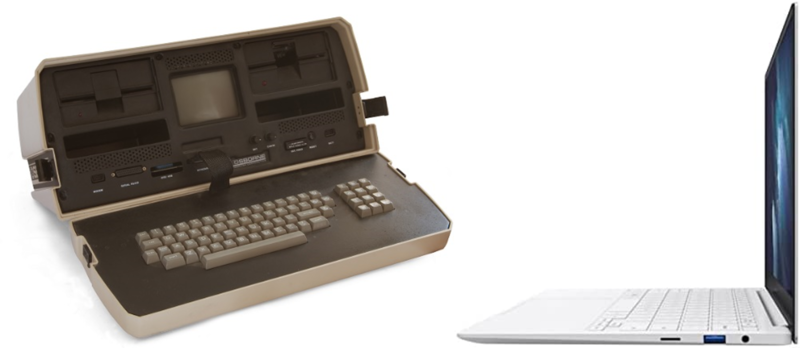
The world’s first “portable” computer, the Osborne 1 (left), and one of the latest laptop models from Samsung, the Galaxy Book Pro (right). (Left image: Wikimedia commons CC 3.0, Right image: © Samsung Display).
The Laptop Landscape
The laptop/portable device category has expanded to include multiple variations in form and functionality, including:
- Traditional laptops – full-performance, portable PCs typically weighing 5 pounds or more
- Notebooks – thinner, lighter laptops typically 3 pounds or less
- Ultrabooks – high-end notebooks that are even smaller and lighter but offer more functionality at a price tag to match
- Tablets – which offer limited functions (e.g., Internet access, videos, and games but no word-processing or similar work/productivity applications). They are touchscreen controlled without the need for a keyboard
- Two-in-one laptops that combine tablet features (e.g., touchscreens) with PC-like computing power, used with either a built-in or detachable keyboard.
The market for both desktop PCs and laptops has been in flux for the last several years. A gradually declining sales trend suddenly turned around as demand for computing products spiked in the pandemic, notwithstanding current bumps in the road due to shortages of some components. But the future looks bright, according to industry experts and analysts who are predicting slow but steady growth of this already US$103 billion market at a rate of 0.5% CAGR through 2027,1 driven in part by emerging markets in Asia and EMEA.
New Forms and Flexibility
Foldable smart phones have been on the market since 2021—could foldable laptops be far behind?
Manufacturers have been selling various foldable case configurations for a while, yet the screens themselves remained flat. For example, Lenovo’s Yoga models feature flexible hinges that enable a user to fold it into different “poses” like a tent or doubled over to be used as a tablet. The Microsoft Surface Pro 8 folds into “laptop, stage, and studio” configurations for different uses.

The Lenovo ThinkPad X1 Titanium Yoga laptop (left), and Microsoft Surface Pro 8 in “stage” mode. (Left image © Lenovo, right image © Microsoft Corporation)
The first laptop where the display screen itself could bend and fold was the tablet-style Lenovo ThinkPad X1 Fold, which came on the market in late 2020. But no other foldable-screen laptops have emerged until now. At CES 2022 the ASUS Zenbook 17 Fold OLED created a stir. Its hinged display folds down to just 12.5-inches for easy transport but can open out into a 17-inch laptop with OLED-quality visuals.
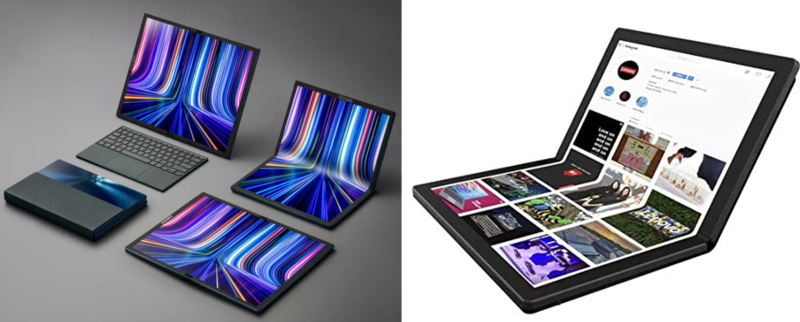
The Asus Zenbook 17 Fold OLED laptop with folding screen surface (left) and the Lenovo ThinkPad X1 Fold that preceded it. (Left image © ASUSTek Computer, Inc. Right image © Lenovo)
Many users have become used to a workstation set up that includes more than one monitor for added display space, flexibility, and convenient reference. Soon you could enjoy similar dual-screen viewing convenience on the go. Another laptop model that received a lot of attention was Lenovo’s ThinkBook Gen 3, which integrates an entire second screen next to the keyboard. Previous Lenovo ThinkPad models offered an E-ink display embedded on the lid of a 13-inch laptop.
At 8”, the new side screen can be used as a supplemental display—for smartphone mirroring, or for applications and tools such as a calculator, a chat window, or to take notes. It offers 800x1200 resolution with touchscreen/stylus capability.
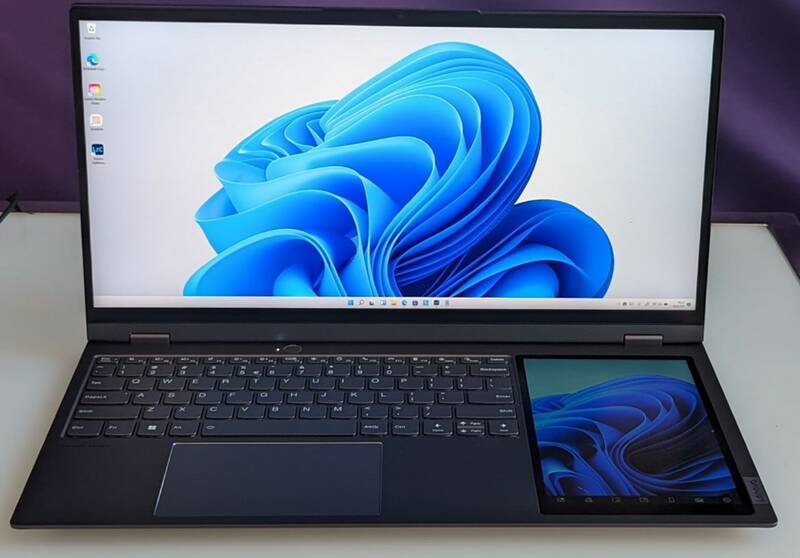
Lonovo’s ThinkBook Plus Gen 3 offers a full-size 17.5-inch display screen with a second 8” display alongside.
Dell previewed a “minimalist and modern”2 design for its newest XPS 13 laptop featuring an edge-to-edge keyboard that allows the keys to be larger. The top row of function buttons was replaced by a smooth touchscreen strip. Meanwhile HP showed its new Elite Dragonfly Chromebook laptop designed with today’s remote/hybrid workers in mind. It weighs just 2.2 lb (just under 1 kg) with a taller display for easy scrolling, and a webcam feature that stays focused on your face even if you move around the room during video meetings.
Ensuring Laptop Display Quality
With so many models, performance specifications and features available from multiple brands at a wide range of price points, today’s laptop customers can pick and choose exactly the system they desire. But once they’ve considered specs such as processor speed, memory, and battery life, ultimately the display provides the “wow-factor”—the visual impact that can sway a buyer’s decision.
Humans are visually oriented creatures, and a display’s brightness, clarity, vivid color, and perfect uniformity is critical. Manufacturers must inspect laptops and other display devices during production and final assembly to ensure there are zero defects and a flawless product appearance right out of the box. Radiant’s solutions for display measurement and inspection rely on photopic systems that match the sensitivity of the human eye, to “perceive” displays how customers will see them.
Our ProMetric® Imaging Photometers and Colorimeters, paired with our TrueTest™ Software, are one of the display industry’s leading automated optical inspection (AOI) solutions. Thousands of our systems are deployed worldwide in the factories of major consumer device manufacturers. With high-resolution, low-noise, scientific-grade sensors, ProMetric cameras capture the entire display in detail in a single measurement image for evaluation. This ensures that manufacturers have the clearest images for pixel-level defect inspection of LCD, OLED, microLED, and other backlit and direct-view displays.
Radiant’s FPD Conoscope Lens enables view angle performance measurement, capturing the angular distribution of color, luminance, and contrast in a single measurement for quick, accurate evaluation of a display seen from multiple perspectives. Radiant uses Fourier optics that map an emitting spot to an image sensor so that each pixel corresponds to a different emission angle up to ±70 degrees.
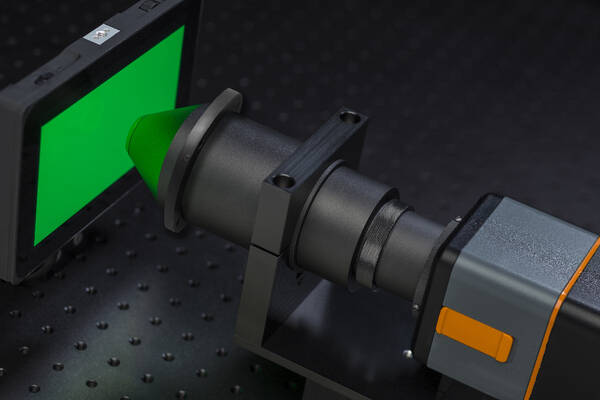
A ProMetric Y-Series Imaging Photometer and the FPD Conoscope Lens, which uses Fourier optics to take high-resolution photopic measurement of the angular distribution of color, luminance, and contrast for displays and display components.
Using Radiant’s TrueTest™ Software, production teams can test displays for:
- ANSI brightness
- ANSI color uniformity (CIE x,y and CIE u’,v’ coordinates)
- Light or color mura (blemish)
- Light leakage
- Pixel and line defects
- Image sticking
To learn more about these display inspection solutions, watch a video demonstration:
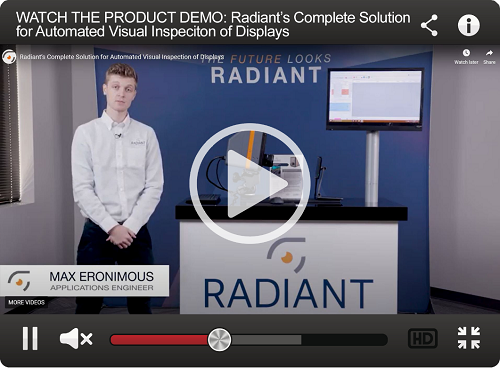
To help manufacturers ensure the quality of OLED and microLED devices, Radiant has also developed patented methods for demura, a process of measuring and correcting emissive displays. To learn more about pixel measurement and correction of emissive displays, read the white paper, “How to Use Imaging Colorimeters to Correct OLED, microLED, and Other Emissive Displays for Improved Production Efficiency and Yields.”
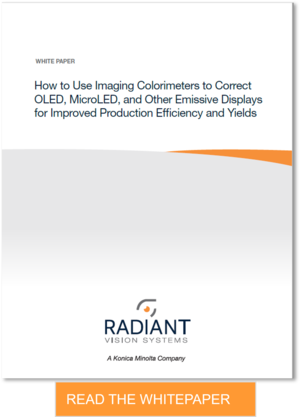
CITATIONS
- Global Laptop Market Report, Expert Market Research, Accesed January 13, 2022.
- Goldman, J., “HP’s ultralight Elite Dragonfly laptop brings a Chromebook friend to CES 2022.” C|Net, January 6, 2022.
Join Mailing List
Stay up to date on our latest products, blog content, and events.
Join our Mailing List
